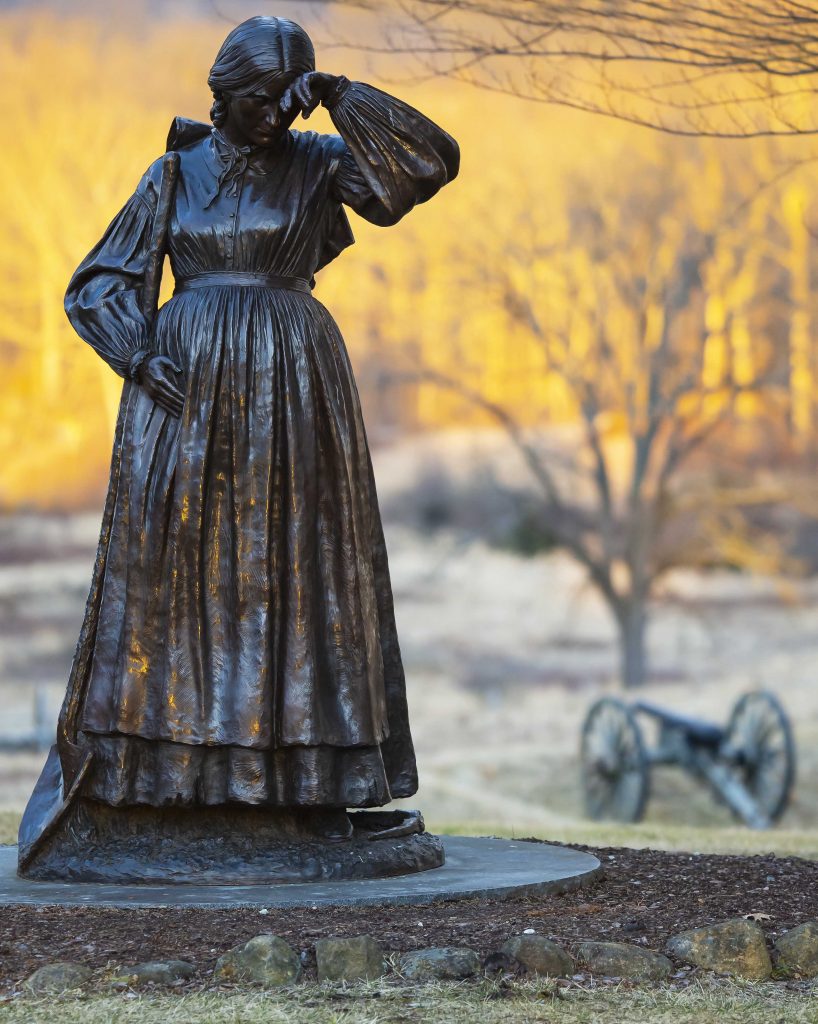2022 Women’s History Month with Emerging Civil War

March is Women’s History Month, and ECW will be highlighting some extra accounts about women and their experiences, achievements, and challenges connected to the Civil War and 1860s.
Chris Heisey’s photograph from Gettysburg’s Evergreen Cemetery contrasts Eliza Thorn’s courage and difficult experiences when war and cannons literally took over her home. With her husband away serving in the 138th Pennsylvania Infantry, Eliza, her three little boys, and elderly parents refugeed away from their dwelling — the gatehouse of Evergreen Cemetery, located on Cemetery Hill. She was pregnant at the time of the battle, and later gave birth to a baby girl in November 1863.
But when they returned a few days after the battle ended:
“Everything in the house was gone except three feather beds and a couple of pillows. The beds and a dozen pillows we brought from the old country were not fit to use again. The legs of six soldiers had been amputated on the beds in our house and they were ruined with blood and we had to make way with them.
“It was a busy time for father and me when we got back. We would get orders to dig graves and father and I dug 105 graves for soldiers in the next three weeks. When I left home the first time I had put on a heavier dress than usual and when we got back there wasn’t a single piece of our clothing left. I lived in that dress for six weeks.
“Sixteen soldiers and one colored man had been buried in the garden near the pump house. In one field lay fifteen dad horses and in the other field nineteen dead horses. They were right beside the cemetery and were not buried and the stench was awful. For days I could hardly eat because of the disagreeable odor.
“For all the extra work of burying the soldiers we never received any extra pay from the cemetery or from any other source, only the monthly salary of $13.00….”
Women’s History Month can be a time to highlight the successful stories that make us feel proud or hopeful to learn lesser-known accounts. But it can also be a time to reflect of the stories of courage and sacrifice that are directly tied to battles we are highly-familiar with. Eliza Thorn’s home sat at the heart of the Union line during the Battle of Gettysburg, where Howard and Hancock rallied the troops on Day 1, where the Louisiana Tigers attacked on Day 2, and within artillery bombardment range on Day 3. The soldiers left behind death and destruction. Eliza, and hundreds of other civilians across the combat zones around Gettysburg, had to clean up the aftermath and literally bury the dead left in the house and yard.
Part of the goal of Women’s History Month is to focus on the lesser-known stories. Stories that need to “emerge.” Almost every Civil War battlefield holds a civilian — often a woman’s — story. Perhaps as a soldier in disguise, a spy, an influential socialite, an “ordinary” farmgirl, a mother, a sister, a wife. We cannot expect to find their biographies and stories at the heart of a military report or military history, but we can choose to look a little deeper and see how a military fight affected the homefront as a whole or an individual girl or woman. The actions on the battlefields directly affected women’s lives and shaped the culture they lived in.

Thank you for the post, Sarah. Mrs. Thorn’s recollections above are compelling and remind me of the truth that the true heroes were those who fearlessly dealt with the horrible aftermath of the battles at Gettysburg. I had a great time waiting for the late winter, evening light to splash itself on East Cemetery Hill. It only cut through the clouds for a few seconds. Great light is always elusive.